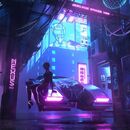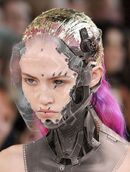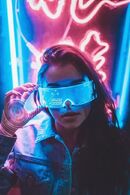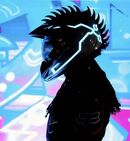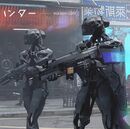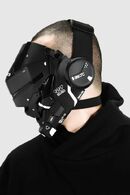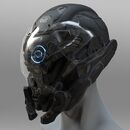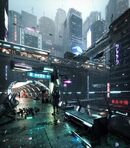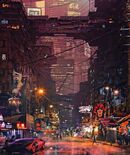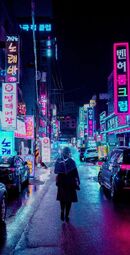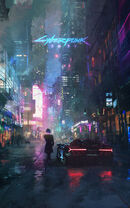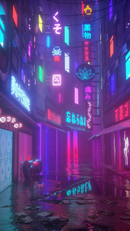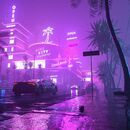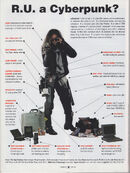Cyberpunk, as a genre, includes a wide variety of visual aesthetics but is recognized by its encompassing theme of "high tech, low life". This became prominent in the 1980s. thanks to the works of authors like Philip K. Dick, Roger Zelazny, J. G. Ballard, Philip Jose Farmer, William Gibson and Harlan Ellison as they examined the impact of drug culture, technology, and the sexual revolution while avoiding the utopian tendencies of earlier science fiction.
Settings in the cyberpunk genre range from the richly (neon) colored, rough-around-the-edges urban jungles of Akira (1988), to the hyper-futuristic, neon cityscapes and bleak wastelands of Blade Runner 2049 (2017), with the first work in cyberpunk fiction being Katsuhiro Otomo's AKIRA manga (1982). William Gibson's Neuromancer (1984) novel has been credited as another defining magnum opus of the genre.
Cyberpunk narratives often incorporate a sense of hopelessness or nihilism, typically featuring a gritty and violent backdrop, with crime, artificial intelligence, class uprising, governmental and corporate corruption, anarchy, gang warfare, and transhumanism all being central themes. The range is broad but the combination of these themes in the cyberpunk aesthetic is often used to convey deeper meanings and commentate on modern society and sometimes predictions of future society.
Cyberpunk was likely the partial inspiration (or anti-inspiration) for Solarpunk - an aesthetic that also aspires to cast a glance into the future, but does so with a much less nihilistic perspective and played a role in inspiring Vaporwave since both seem to share a seeming disdain for mainstream capitalism, but Vaporwave is more sarcastic and mocking compared to Cyberpunk, which is more open with its disdain for the corporate dystopia. In truth, most online aesthetics almost completely owe their entire existence to Cyberpunk and its rebelliousness to the status quo of the 1980s; everything from the Steampunk and Dieselpunk of yesteryear to any sort of micro-genres that will pop up in the future.
Philosophy[]
Transhumanism[]
Transhumanism is an international political movement that advocates for the transformation of the human condition by developing and making widely available sophisticated technologies to greatly enhance human intellect and physiology. This very philosophy has very close ties to the Cyberpunk aesthetic in that, what's more Cyberpunk than becoming part human/part machine? There have also been numerous examples of protagonists in Cyberpunk fiction that are transhuman in their own right (most famously, Motoko Kusanagi from Ghost in the Shell is an example of Transhumanism in Cyberpunk). Cyberpunk media discusses the morals of this philosophy and how it could blur the lines between human and machine and invoke potential ethical and social inequalities.
Cybersecurity and Hacker Culture[]
Cybersecurity (also known as information security or infosec), is the practice of protecting computer systems and data from security hackers, cybercriminals, spies, or other bad actors.[1] "Hackers" are now generally understood to be bad actors, but hacker culture reclaims the label for people who see programming and computer systems as a medium of freedom and creativity.[2]
The "high tech, low life" nature of cybersecurity is often reflected in the offensive and defensive security operatives of cyberpunk fiction and media. In Neuromancer, the protagonist Henry Case is a security hacker working to penetrate corporate computer networks. In Ghost in the Shell, Motoko Kusanagi is referred to as a hacker as short hand for her programming ability which she uses to investigate and prevent cybercrime.
Many characters in cyberpunk fiction and media embody hacker culture and the hacker ethic, which asserts that all information should be free.[3] The protagonists of The Matrix embody the late 1990s self-image of hackers attempting to free humanity from corporate dominiation of technology.[4] Today, many advocates and users of free and open source software adopt a cyberpunk aesthetic, as demonstrated by the r/unixporn subreddit.
The Cyberpunk community has a strong interest in privacy and cybersecurity.[5] Members of the community advocate improving personal privacy and security by using tools like open-source operating systems, secure browsers and VPNs.[6]
Fashion[]
Main Article: Techwear
Cyberpunk fashion is heavily influenced by films like Johnny Mnemonic, Blade Runner, and The Matrix and could be interpreted as being "futuristic gothic fashion" and involves trench coats, boots, shiny black clothing, colored "dreads" that women might wear, etc. Although, Techwear is not the only notable fashion influence when it comes to Cyberpunk. Warcore and Darkwear also heavily inspire the idea of Cyberpunk fashion. Warcore takes war-like / associated motifs like utility vests, cargo pants, and maximalism in its abundance of buckles, straps, and other utility accessories. Darkwear on the other hand is more minimalistic. Darkwear takes streetwear silhouettes and flips them into darker, usually monochrome, pieces and outfits. It's similar to Warcore, but as if you've taken away the maximalism aspect.
Brands[]
- Kclot
- Machine 56
- Holy Grail
- Anthony Wang
- Koyye
- Demonia shoes
- MXDVS
- Techwear Club
- Fabric of the Universe
- White Rock 2008 (*this shop is in Taiwanese currency)
- IMMENSE
While every brand listed may not be dedicated to one aesthetic, each brand has a notable amount of products that can be incorporated into Techwear, Warcore, and Darkwear, which are often associated with the cyberpunk aesthetic as a whole.
These are also only bigger brands. Platforms like Etsy and Depop are great for finding pieces that match this aesthetic with just a quick search.
Media[]
Cyberpunk has been very influential to film and television, inspiring the aesthetics of movies, television shows, and anime. There just seems to be something encoded into the DNA of cyberpunk that makes it incredibly compatible with a lot of future-themed speculative media, even that aimed for children (an argument could even be made that the Sonic SatAM series from the '90s is something of an example of cyberpunk since it involves a group of freedom fighters fighting back an oppressive technologically-based regime run by Dr. Robotnik).
Movies[]
- Blade Runner (1982)
- Max Headroom: 20 Minutes into the Future (1985)
- RoboCop 1/2/3 (1987-1993)
- The Running Man (1987)
- Back to the Future Part II (1989)
- Tetsuo: The Iron Man (1989)
- Circuitry Man (1990)
- The Lawnmower Man (1992)
- CyberTracker (1994)
- Johnny Mnemonic (1995)
- Hackers (1995)
- The Matrix (1999)
- Metropolis (2001)
- Idiocracy (2006)
- Babylon A.D. (2008)
- TRON: Legacy (2010)
- Total Recall (2012)
- Snowpiercer (2013)
- Ghost in the Shell (2017)
- Blade Runner 2049 (2017)
- Next Gen (2018)
- Hardware (1990)
TV Shows[]
- Altered Carbon (2018-2020)
- Batman Beyond (1999-2001)
- Black Mirror (2011-)
- Infinity Train (2019-2021)
- Reboot (1994-2002)
- Almost Human (2013-2014)
- Love, Death & Robots (2019-)
- Captain Lazerhawk: A Blood Dragon Remix (2023)
YouTube Series[]
- Meta Runner (2021-2022)
- Amor de otro Mundo: Éxtasis (2023-)
Anime[]
- Bubblegum Crisis (1987)
- Neo Tokyo (1987)
- AKIRA (1988)
- Appleseed (1988)
- AD Police Files (1990)
- Cyber City Oedo 808 (1990)
- Æon Flux (1991)
- Battle Angel Alita (1993)
- Ghost in the Shell (1995)
- Neon Genesis Evangelion (1995)
- Armitage III (1995)
- Blame! (1997)
- Serial Experiments Lain (1998)
- Jin-Roh (1999)
- Heat Guy J (2002)
- Baldr Force EXE Resolution (2002)
- Project .hack (2002)
- Mardock Scramble: The First Compression (2003)
- Texhnolyze (2003)
- Parasite Dolls (2003)
- Sky Blue (2003)
- Paranoia Agent (2004)
- Psycho-Pass (2012-)
- Ergo Proxy (2006)
- Pale Cocoon (2006)
- Vexille (2007)
- Eve no Jikan (2008)
- Exaella (2011)
- Night Head 2041 (2021)
- Cyberpunk: Edgerunners (2022)
Games[]
The cyberpunk genre has spurred the creation of various cyberpunk-themed video games such as Cloudpunk, Va-11 Hall-A, and most notably Cyberpunk 2077.
- 2064: Read Only Memories (2015)
- Æon Flux (2005)
- Akira (1988)
- Anachronox (2001)
- Angel Devoid: Face of the Enemy (1996)
- Blade Runner (1997)
- Cloudpunk (2020)
- Cruelty Squad (2021)
- Cyberpunk 2077 (2020)
- Half-Life 2 (2004)
- Oddworld: Abe's Oddysee (1997)
- Cytus II (2018)
- Deus Ex (2000)
- Dislyte (2022)
- Edgerunners inc. (1995)
- E.Y.E: Divine Cybermancy (2011)
- Frame City Killer (Cancelled)
- Gemini Rue (2011)
- Ghost in the Shell (1997)
- G-String (2020)
- Hard Reset (2011)
- .hack//G.U. (2006)
- Hover (2017)
- Huntdown (2020)
- Hypnospace Outlaw (2019)
- I Have No Mouth, and I Must Scream (1995)
- Ingress: The Animation (2013)
- Kane & Lynch 2: Dog Days (2010)
- Limbus Company (2023)
- Mirror's Edge Catalyst (2016)
- Neocron (2002)
- Neuromancer (1988)
- Observer (2017)
- Paradise Cracked (2002)
- Primordia (2012)
- Raid 2020 (1989)
- Remember Me (2013)
- Rez Infinite (2016)
- Rise of the Dragon (1990)
- Ruiner (2017)
- Saints Row IV (2013)
- Shadowrun (2007)
- Snatcher (1988)
- State of Mind (2018)
- Starfield (2023) (Neon city and Ryujin Industries faction)
- Stray (2022)
- Syndicate (2012)
- System Shock (1994)
- Technobabylon (2015)
- The Ascent (2021)
- The Red Strings Club (2018)
- The Last Station (2016)
- The Solitaire Conspiracy (2020)
- The Spectrum Retreat (2018)
- Transistor (2014)
- Uplink (2001)
- Va-11 Hall-A (2016)
- VirtuaVerse (2020)
- Neon District (Roblox) (2011)
Literature[]
Authors[]
- Katsuhiro Otomo
- Pat Cadigan
- William Gibson
- Rudy Rucker
- Lewis Shiner
- Bruce Sterling
- Ernest Cline
- T. R. Napper
Books[]
- AKIRA (1982), by Katsuhiro Otomo
- The Demolished Man (1953), by Alfred Bester
- Ready Player One (2011), by Ernest Cline
- Do Androids Dream of Electric Sheep? (1968), by Philip K. Dick
- Agency (2020), by William Gibson
- Neuromancer (1984), by William Gibson
- Pattern Recognition (2003), by William Gibson
- Altered Carbon (2002), by Richard Morgan
- Snow Crash (1992), by Neal Stephenson
- Accelerando (2005), by Charles Stross
- 36 Streets (2022), by T. R. Napper
TTRPG[]
- Cyberpunk (1988)
- Shadowrun (1989)
- Rifts (1990)
- Violet Sheep Happy Hunting (2022)
Music[]
While Cyberpunk itself is not a genre of music (nor does it have one genre associated with it), there are some characteristics of music that tend to make it sound Cyberpunk. These characteristics include the use of synthesizers, Cyberpunk themes, and sounding dark without being Darkwave. Synthwave and Synthpop music tends to sound Cyberpunk.[7]
It can be argued that many futuristically influenced 80s synthpop and New Romantic bands influenced the music and aesthetic of what would later be dubbed Cyberpunk.
Gary Numan, whose music was heavily inspired by the work of Phillip K. Dick, was one of the major purveyors of this early iteration of the genre. His album Replicas is a perfect example of what Cyberpunk should sound like.
Artists[]
- Gary Numan
- Japan (specifically the album Gentlemen Take Polaroids)
- John Foxx
- Ministry/PTP (Show Me Your Spine)
- Notre-Dame of Tokyo
- Sigue Sigue Sputnik
- Scandroid
- Perturbator
- Neon Neon
- Health
- Essenger
- Kraftwerk
- Daniel Deluxe
- Excision
- KITCALIBER
- Daft Punk (specifically the album Human After All)
Podcasts[]
Cyberpunk podcasts include podcasts that are related to cyberpunk interests, including science, technology, privacy, and cybersecurity.
- Defense One Radio (2018-)
- Inside Skunk Works (2018-)
- Omega Tau (2008-)
- Moonshot (2017-)
- Planetary Radio (2002-)
- Robohub Podcast (2009-)
- The SynBioBeta Podcast (2019-)
- This Week in Microbiology (2011-)
- Titans of Nuclear (2018-)
Subgenres and Derivatives[]
Biopunk[]
Biopunk is a subgenre of Cyberpunk that focuses on biotechnology.
For more information, see Biopunk.
Bronzepunk[]
Bronzepunk takes Greco-Roman aesthetics and puts them into a pseudo-modern world. The name comes from the use of bronze-age technology, albiet with modern twists.
For more information, see Bronzepunk.
Clockpunk[]
Clockpunk takes elements of Cyberpunk and puts them into a Renaissance setting. Some call it steampunk without the steam.[8]
For more information, see Clockpunk.
Ironpunk[]
Ironpunk adds traits of Cyberpunk to an Iron Age setting.
Nowpunk[]
Nowpunk essentially says that Cyberpunk is now. Bruce Sterling used it to describe his 2005 novel, titled The Zenith Angle.
Solarpunk[]
Solarpunk is the opposite of cyberpunk. It features an optimistic view of the future, emphasizing renewable energy, handcrafted wares, and anti-capitalism.
For more information, see Solarpunk.
Lunarpunk[]
Lunarpunk is closely related to Solarpunk with its emphasis on nature and renewable energy, with an addition of witchcraft.
For more information, see Lunarpunk.
Afrofuturism[]
Afrofuturism takes element from african culture and traditions and incomporate sci-fi elements.
For more information, see Afrofuturism.
Tupinipunk[]
Tupinipunk refers to the Brazilian sci-fi/cyberpunk movement. This is a criticism of the Euro-centric and US-centric views that tend to dominate Cyperpunk.
For more information, see Tupinipunk.
Criticisms[]
Techno-orientalism[]
Cyberpunk often incorporates elements of Asian culture, particularly from Japan and Hong Kong, into its visual and narrative motifs. Critics argue that this can sometimes result in a shallow and appropriative portrayal of Asian cultures, reducing them to exotic and fetishized stereotypes.
Technological determinism[]
Cyberpunk often portrays technology as the driving force shaping society, sometimes overlooking the complex interplay between technology, politics, and social dynamics. Critics argue that this deterministic perspective can oversimplify the complexities of societal change and overlook other factors influencing the future.
Resources[]

Cyberpunk Fashion
External links to help get a better understanding of this aesthetic.
Communities[]
Vendors[]
- CRISISWEAR
- Cryoflesh
- Cyberdog
- DUSTRIAL
- Futurestate
- High-Cyber Gypsy
- Memetic Tees
- Neo4ic
- Plastik Wrap
- R.A.G.E. Nation Apparel
- ZOLNAR
Playlists[]
- Cyberpunk Community Soundtrack
- Neo Tokyo - Cyberpunk Mix
- Cyberpunk | Retro Future Spotify playlist by aofd3
- Cyberpunk Ambiance ||| Night Spotify playlist by ihonestlyd0ntcare
- Cyberpunk Synthwave Spotify playlist by elisamunoz3
- Cyberpunk Spotify playlist by Timothy Walschaerts
- Cyberpunk / Future Spotify playlist by wongjp
- Cyberpunk Chill Spotify playlist by 12102695653
- Cyberpunk Study Music Spotify playlist by Jason David
- cybernoir Spotify playlist by demixian
- electro punk -ish Spotify playlist by sleepyyjax
- Cyberpunk [YT] by Triopse | Captain Drown
- Cyberpunk [Spotify] by Triopse | Captain Drown
Gallery[]
References[]
- ↑ https://en.wikipedia.org/wiki/Information_security
- ↑ https://en.wikipedia.org/wiki/Hacker_culture
- ↑ https://en.wikipedia.org/wiki/Hacker_ethic
- ↑ https://en.wikipedia.org/wiki/The_Cathedral_and_the_Bazaar
- ↑ https://cyberpunkforums.com/viewtopic.php?id=3160
- ↑ https://cyberpunked.org
- ↑ https://www.reddit.com/r/Cyberpunk_Music/comments/5xmtwu/how_would_you_define_cyberpunk_music_in_terms_of/
- ↑ http://ingmaralbizu.com/clockpunk-and-the-perils-of-reimagining-the-past/











